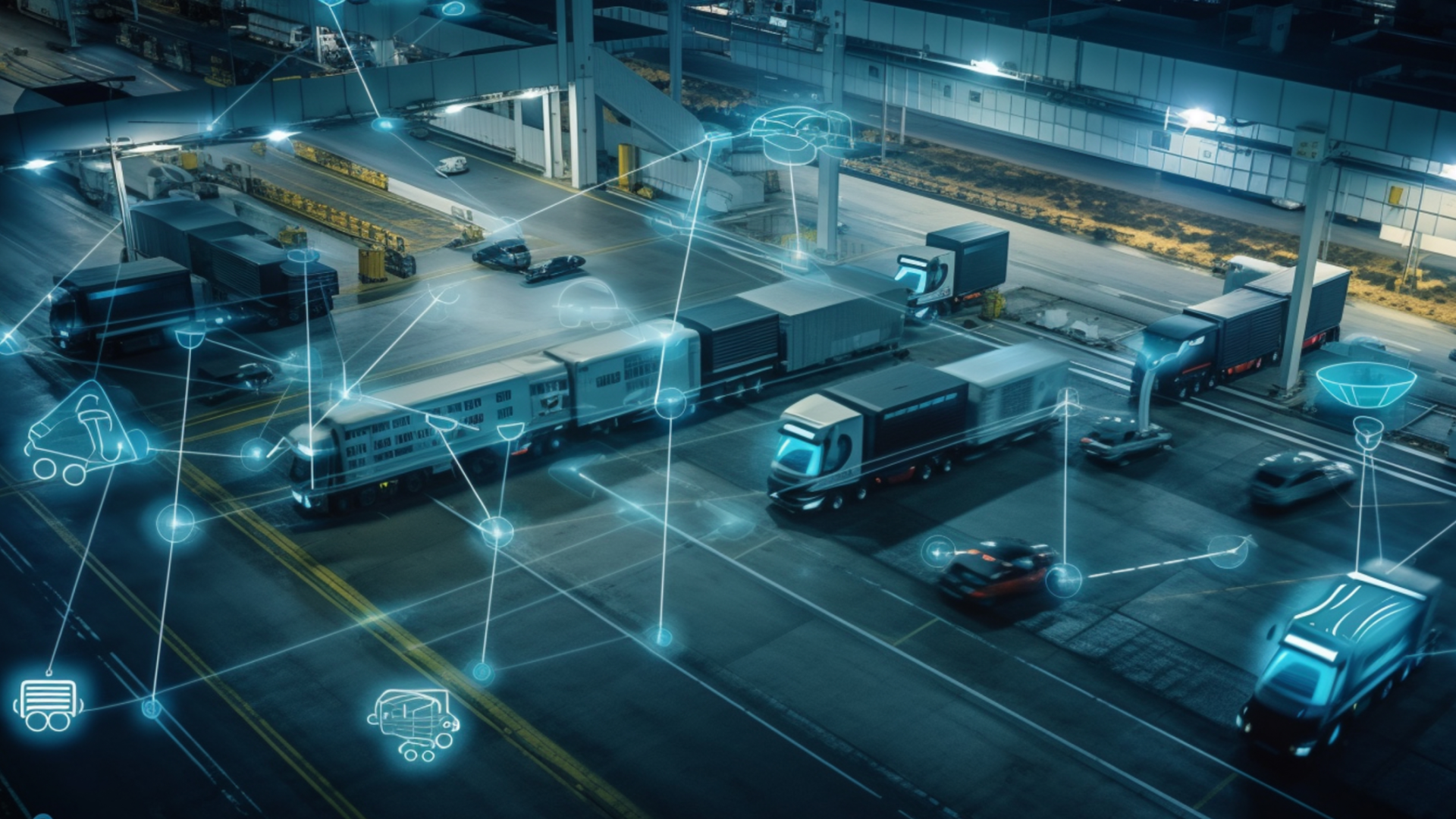On the one hand, everyone is used to the fanfares heralding the advent of AI into every industry ever, logistics being no exception. On the other hand, when we switch into the logistics proper, there’s a notable disparity between the potential benefits of advanced technologies and their actual adoption rates.
In this article, we draw on our own expertise in establishing AI-powered logistics systems, as well as other famous case studies to create a concise guideline for eliminating the possible risks and help your company step on the right path when adopting AI systems.
State of AI in Supply Chain and Logistics
According to a recent survey by YouGov, the logistics sector appears to be at a crossroads in this regard: while half of the transportation and logistics professionals across the three surveyed countries acknowledge the use of basic data analytics in their operations, the adoption of AI remains relatively low, with only 25% of respondents reporting any use of AI technologies within their organizations.
At the same time, by 2025, most respondents in a different survey consider there will be no escape from AI in logistics, and it will become a crucial part of their processes. This is a picture of an industry where the decision makers are (at the same time) eager to reap the benefits but wary of the possible risks. Just like your average Joe on December 31st, making his New Year’s Eve resolution to get into jogging/yoga/arts&crafts/whatever: maybe I will, but who knows if I manage to keep it up past January the 2nd?
The difference being, you can go out jogging once and then quit it, while AI implementation is a bigger investment. The benefits are much, much bigger, though.
The Benefits and Use Cases of AI in Logistics
The promise of Artificial Intelligence (AI) in revolutionizing the supply chain and logistics industry is not just theoretical. The old rule of the early bird getting the worm is now being observed once again: the adoption of AI technologies has been shown to improve logistics costs by 15% for the early adopters, indicating a substantial boost in operational efficiency and cost optimization. Thinking of how notoriously margin-tight the logistics and transportation industry is, even slight reductions in costs can lead to significant competitive advantages.
Moreover, the impact of AI on inventory management and service levels is even more remarkable. Companies leveraging AI for supply chain management have reported a 35% reduction in inventory levels, which translates to less capital tied up in stock and more flexibility to respond to changing market demands. Additionally, these early adopters have seen a 65% improvement in service levels. This substantial increase demonstrates how AI can help enhance customer satisfaction through improved accuracy, faster delivery times, and more reliable service overall.
AI’s “talents” at dynamic routing ensure that unexpected delays or road conditions can be swiftly accommodated, enhancing reliability and efficiency in deliveries. The potential benefits extend beyond individual companies to city-wide traffic management systems, where AI can contribute to reducing overall congestion, further amplifying the positive environmental and operational impacts.
In the realm of driver monitoring, vehicle control, and the advent of autonomous vehicles, AI is setting the stage for unprecedented levels of safety, efficiency, and autonomy in logistics. Through AI-driven analytics, logistics companies can monitor driver behavior in real-time, helping to prevent accidents and ensure safer driving practices. Meanwhile, AI’s role in vehicle control, particularly in autonomous vehicles, promises to transform the logistics industry by enabling 24/7 operation without the constraints of human driver limitations, thereby significantly increasing productivity.
Consult our article on the practical applications of AI in Logistics for more information.
On another front, there’s the customer (who, in logistics, is always waiting for the delivery). Chatbots can handle a multitude of customer service inquiries simultaneously, providing instant, accurate responses, and personalized communication. This not only improves the customer experience but also frees up human resources to focus on more complex tasks.
The Challenges and Misconceptions about AI in Logistics
So what’s really hindering AI adoption in logistics? The typical challenges can be classified into two groups based on how real they are: myths/misconceptions (i.e. the challenges that the AI services vendor will actually take care of), and real-life risks (that is, the ones that require actual input from the company.)
One of the prevailing misconceptions about integrating Artificial Intelligence (AI) in logistics is the idea that implementing it “might take ages.” However, this perspective often overlooks the advancements in AI technology designed for rapid deployment and the increasing availability of off-the-shelf AI solutions tailored to the logistics sector. While it’s true that large-scale, deeply customized AI implementations can be complex and time-consuming, many AI applications can now be integrated relatively quickly, offering immediate benefits such as improved efficiency and cost savings. The root of this myth is that people tend to disregard the modular nature of many modern systems, which are designed to grow with the business, allowing companies to start small and scale up AI capabilities as needed.
Another misconception is that adopting AI means plunging headlong into tech while firing the human employees, restructuring the entire budget to pour the money freed by the dramatic layoffs into enabling the Great Transition. Not true. While initial investments are often required, the long-term cost savings and operational efficiencies gained through AI can offset these initial expenditures, so the transition is not that dramatic after all. For example, AI-driven route optimization and inventory management can lead to substantial reductions in fuel costs and inventory carrying costs, respectively. Moreover, the fear of extensive worker layoffs overlooks the potential for AI to augment human work rather than simply replace it. AI can take over repetitive, mundane tasks, freeing up employees to focus on more strategic, value-added activities. This not only can lead to more fulfilling roles for workers but also drives innovation and growth within the logistics sector.
Now, to the actual risks (not that these ones can’t be mitigated.) One of the major challenges in employing AI and Machine Learning models is that they really do thrive on accurate data; flaws in the data fed into these systems can lead to problematic outputs and decisions. For instance, inaccurate input data could result in suboptimal routing in logistics operations, causing unnecessary delays and costs.
Another significant challenge in the practical implementation of AI is the skilled talent. An effective AI transformation strategy must consider these potential disruptions and place a heavy emphasis on change management to ensure a smooth transition.
Implementing AI in Logistics while Minimizing Risk
So what are the ways to handle the actual risks while enjoying the benefits of AI? As of 2024, there have been numerous cases of AI in logistics, and none of the companies figuring there have suffered any catastrophes – so here are the takeaways from their practical cases.
Eliciting the ROI from Artificial Intelligence in Logistics
First and foremost is, of course, eliciting the actual ROI, and how soon it will happen. The key here is in careful strategizing and priority setting. Realizing the maximum benefit from AI investment often depends on accurately determining the most crucial direction for your business.
There can be several courses of actions based on what direction in your company’s operations is the one most likely to be positively transformed with AI. These are:
- optimizing maintenance
- enhancing route management
- improving customer-facing function
For instance, if your business operates in a highly competitive market where customer service is a significant differentiator, then investing in AI technologies to improve customer-facing functions, like chatbots or AI-enhanced communication and tracking systems, could significantly boost customer satisfaction and retention, resulting in higher ROI. On the other hand, if your logistics operations are hampered by frequent vehicle breakdowns or inefficient maintenance procedures, adopting AI for predictive maintenance could save you up to 40% compared to the usual reactive maintenance routines. AI can forecast maintenance needs before they result in costly downtime, optimizing operational efficiency and generating significant cost savings.
Similarly, if fuel costs or delivery times are a major concern, focusing AI enhancements on route optimization could yield substantial returns through lower fuel consumption and higher delivery speed. Each of these potential directions for AI implementation offers its unique set of benefits; signifying the importance of setting the correct direction aligned with your business needs and market demands to maximize ROI.
Overall, the time of ROI depends on how well you determine the initial direction of operations where to implement AI, and also on how well you understand the everyday routine of the employee in the corresponding departments.
Operational Risks and How to Choose the Right AI
So the ROI from AI in logistics can be ensured with adequate strategy and consulting, but what about the purely operational risks? It turns out, you can mitigate these, as well, utilizing several useful tactics.
Data Quality and Volume
Robust data management is important here, and what’s interesting, AI actually helps develop these strategies. This approach involves, first of all, implementing dedicated data governance protocols to ensure data accuracy, consistency, and relevancy. Moreover, leveraging data validation techniques or tools that can automatically identify and correct errors or inconsistencies in the data can significantly improve data quality. Data enrichment techniques, such as integrating external data or employing advanced analytics to derive more information from existing data, can also enhance the quality and depth of data available.
But what if the available actual data is insufficient? One approach is to utilize synthetic data — artificially generated data that mimics the properties of the real data — to supplement your existing datasets. This can provide the volume necessary to effectively train AI models without needing massive real-world datasets. Another approach is to leverage data augmentation techniques, which involve artificially expanding the existing dataset by creating modified versions of the data, thereby increasing the volume and diversity of data.
Furthermore, collaboration with partners, suppliers, or other industry players to create shared data resources can also be an effective way to increase data volumes.
Integrations
Another threat is developing a fully functional AI system that just doesn’t fit into your general digital infrastructure. Central to handling this challenge is adopting an API-first mentality, where AI systems are designed to seamlessly communicate with existing software and databases through well-documented, standardized application programming interfaces (APIs). This facilitates easier, more reliable data exchange and functionality between AI and the company’s broader IT infrastructure, ensuring that AI-driven insights and enhancements are effectively applied across the logistics operations. Moreover, investing in middleware or integration platforms can serve as a powerful bridge, making the connection between disparate systems more fluid and less prone to errors or performance bottlenecks. These platforms can also offer additional layers of security, which is critical when handling sensitive logistics data.
Talent
Another commonly voiced objection is “we don’t have the resources to hire and/or onboard the talent to handle AI.” This one’s best solved through differentiating between the talent needed to develop the system, and the talent needed to work it.
By partnering with AI consultancies or specialized software development firms, companies can tap into a diverse pool of expertise that might be lacking in-house. Outsourcing can solve critical skills gaps, providing access to professionals who have the requisite experience in AI logistics platforms, from the conceptualization and development phase to the deployment and testing stages. This enables companies to not only kick-start their AI projects more efficiently but also learn from the expertise of these third-party entities.
Once the AI systems for logistics are developed and ready for deployment, the focus shifts towards leveraging in-house capabilities to ensure smooth operation and maintenance of these platforms. In-house training becomes essential to enable staff to effectively use and interact with the new AI tools. Developing training programs that are tailored to the existing workforce’s skill levels and the specific functionalities of the AI systems is crucial.
Regulatory concerns
Minimizing the risks connected with regulatory and legal standards during AI implementation in logistics calls for a proactive and well-informed approach. There are things like the GDPR in the European Union, and similar privacy laws in other jurisdictions, as well as industry-specific regulations, such as the International Maritime Organization’s guidelines for autonomous ships. Legal assessments prior to AI implementation in these cases include evaluating how AI systems collect, store, and process data, ensuring all activities align with legal standards. What’s encouraging is that by now, AI services vendors have a thoroughly researched, practical case-endorsed vision of where to look when implementing logistics systems.
Furthermore,regular training sessions for employees on these policies will raise awareness and understanding, fostering a culture of compliance from within. Additionally, incorporating ethics and accountability mechanisms into the AI systems — such as explainable AI (XAI) principles that provide transparency into AI decision-making processes — can further align AI implementations with regulatory and societal expectations.
Conclusions
The dichotomy between aspiration and reality is evident at our current stage of AI adoption in logistics. However, projections paint a picture of inevitability, as more and more companies discover their unique pathways toward utilizing AI. Navigating such a calculated path requires a balanced approach, and by leveraging the tangible benefits AI offers in cost optimization, operational efficiency, and customer satisfaction, logistics companies can lay the groundwork for sustainable growth and competitive advantage.
However, to realize this potential, companies must address key challenges such as data quality, integration complexities, talent acquisition, and regulatory compliance head-on. With a number of AI implementation cases behind our backs, Lionwood offers its expertise in creating AI-powered systems that benefit your organization in a unique way. You can contact our experts for a consultation at any moment.















